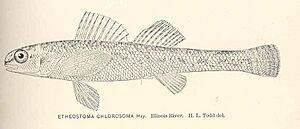Bluntnose darter facts for kids
Quick facts for kids Bluntnose darter |
|
|---|---|
 |
|
| Conservation status | |
| Scientific classification | |
| Synonyms | |
|
The bluntnose darter (Etheostoma chlorosomum) is a small, freshwater fish. It belongs to a group of fish called darters. These fish are part of the larger family that includes perches. You can find bluntnose darters in eastern North America. They like to live in slow-moving or still waters.
Contents
What is a Bluntnose Darter?
The bluntnose darter gets its name from its very round, blunt snout. It can grow up to about 2 inches (5.1 cm) long. Its body is light yellow or olive on top. It often has dark brown or black spots or lines. The belly of the fish is white. You might see W-shaped marks on its sides. There are also black bars around its snout, even extending a little onto its upper lip.
Its top fin (dorsal fin) and tail fin (caudal fin) have light brown bands. The other fins are clear, meaning they don't have much color. This fish has an incomplete lateral line, which is a special sense organ.
How Bluntnose Darters Change for Breeding
When it's time to breed, male bluntnose darters change color. They become darker or a bit dusky. Small bumps, called breeding tubercles, grow on their bottom fins. Female darters also develop a special, flat organ for laying eggs.
Where Bluntnose Darters Live
Bluntnose darters live across a wide area in North America. You can find them from Texas all the way east to Mississippi, Alabama, and Indiana. They also live north into Minnesota. These fish prefer places like swamps, lakes that form on floodplains, and slow-moving creeks. They often live where the bottom is muddy, clay, or covered with plant bits. Even in big rivers, they like to stay in calm, quiet areas.
What Bluntnose Darters Eat
Bluntnose darters are insect eaters. Studies in Tennessee showed that they mostly eat aquatic insects. This includes things like caddisfly larvae, certain types of beetles, and midge larvae. These are all small bugs that live in the water.
Reproduction and Life Cycle
Bluntnose darters likely live for about three years. They don't all spawn (lay eggs) at the same time of year. It depends on where they live. For example, in Texas, they might spawn from January to March. In Kansas, it's usually in April. In Louisiana, they spawn in March and April.
When it's time to breed, the male fish tries to attract the female. He poses and quivers, showing off his fins. The female chooses the spot for laying eggs. She often picks places like algae, dead leaves, or a small twig. The male then joins the female to fertilize the eggs. They usually fertilize only 1 to 3 eggs at a time. Scientists are still learning about how the baby darters develop after hatching.


